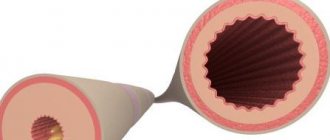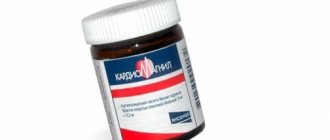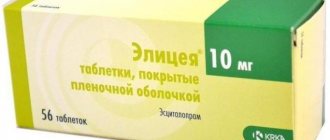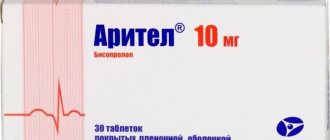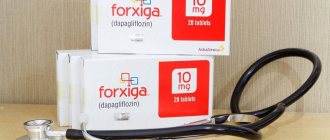Montelukast
The effectiveness of oral administration in the treatment of acute attacks of bronchial asthma has not been established. Therefore, the drug in tablets is not recommended for the treatment of acute attacks of bronchial asthma. Patients should be instructed to always carry emergency medications to relieve asthma attacks (short-acting inhaled beta2-agonists).
You should not stop taking the drug during an exacerbation of bronchial asthma. You should remember the need to use emergency medications to relieve attacks (inhaled (short-acting 33-agonists).
Patients with a confirmed allergy to acetylsalicylic acid and other nonsteroidal anti-inflammatory drugs (NSAIDs) should not take these drugs during treatment with Montelukast, since while it improves respiratory function in patients with allergic bronchial asthma, it nevertheless cannot completely prevent nonsteroidal asthma caused by them. anti-inflammatory drug bronchoconstriction.
The dose of glucocorticosteroids for inhalation or oral administration taken during treatment can be gradually reduced under the supervision of a physician. However, abrupt replacement of glucocorticosteroids cannot be carried out.
Neuropsychiatric disorders have been described in patients taking the drug. Given that these symptoms could be caused by other factors, it is unknown whether they are related to the drug. The physician should discuss this adverse event with patients and/or their parents/guardians. Patients and/or their parents/guardians should be advised that if such symptoms occur, they should notify their physician.
In rare cases, patients receiving anti-asthma drugs, including leukotriene receptor antagonists, have experienced one or more of the following adverse events: eosinophilia, rash, worsening of pulmonary symptoms, cardiac complications and/or neuropathy, sometimes diagnosed as Churg-Strauss syndrome (systemic eosinophilic vasculitis ). These cases have sometimes been associated with dose reduction or discontinuation of oral corticosteroid therapy. Although the causal relationship of these adverse events to leukotriene receptor antagonist therapy has not been established, caution and appropriate clinical monitoring should be exercised in patients taking the drug.
Film-coated tablets, 10 mg, contain lactose monohydrate. Patients with hereditary galactose intolerance, congenital lactase deficiency or glucose-galactose malabsorption should not take the drug.
The desired 5 mg tablets contain aspartame, a source of phenylalanine. Patients with phenylketonuria should be informed that each chewable tablet contains aspartame equivalent to 0.842 mg of phenylalanine. The drug, available in the form of 5 mg chewable tablets, should not be taken by patients with phenylketonuria.
There is no evidence that taking the drug affects the ability to drive a car or drive machinery. However, when using the drug, side effects such as dizziness and drowsiness may occur. In view of this, caution should be exercised when driving vehicles and performing actions that require rapid psychomotor reactions.
Release form and composition of the drug
The pharmacological agent contains sodium montelukast as the main active component. This ingredient comes in the form of a yellowish or white powder that is included in the tablets. Pharmaceutical companies produce oral tablets as well as chewable tablets.
Additional ingredients in the composition may vary, but in most cases the tablets contain the following components:
- Talc.
- Corn or potato starch.
- Macrogol.
- Magnesium stearate.
- Lactose.
- Titanium dioxide
- Povidone.
Montelukast for children
The amount of the main ingredient in the composition can be 10 or 5 mg. The tablets are packaged in blisters of 14 pieces. The cardboard box contains instructions explaining the rules for using the medicine, as well as 1 or 2 plates of tablets.
Side effects
While taking Montelukast chewable tablets, side effects from various organ systems may develop:
- Gastrointestinal tract - nausea, vomiting, diarrhea, pancreatitis, abdominal pain.
- Nervous system – headache, dizziness, periodic convulsions, sensory disturbances, drowsiness.
- Mental health – depression, anxiety, aggressive behavior.
- Musculoskeletal system – myalgia, arthralgia.
- Cardiovascular system – tachycardia.
- Respiratory system – pulmonary eosinophilia, nosebleeds.
- Liver and biliary tract – hepatitis, increased activity of liver enzymes in the blood (ALT and AST).
- Skin and subcutaneous tissue – nodular, erythema multiforme.
- Immunity - allergic reactions (skin rash, itching, urticaria, Quincke's edema, anaphylactic shock).
- Infectious complications - damage to the upper respiratory tract.
Drug interactions
Monteluxt for children (reviews of the medication help evaluate its effectiveness even before starting therapy) and adults can be combined with hormonal medications, as well as non-steroidal anti-inflammatory drugs and antihistamines. In addition, the drug combines well with other drugs aimed at treating bronchial asthma.
It is worth noting that the drug does not increase the dosage of antibiotics in the blood, as well as oral contraceptives, and antitussive medications. With the right combination, the product can be used simultaneously with any medications.
When studying drug interactions, experts found that the only contraindication is taking Montelukast with other drugs containing the same active ingredient. Despite this, you should consult your doctor before taking any additional medication.
Overdose
Montelukast for children (there are negative reviews of the product, which is often associated with an allergy to the medication) rarely provokes an overdose when used correctly. However, with long-term use of increased dosages of the medication, there is a worsening of all negative reactions, as well as a significant deterioration in the patient’s condition.
Patients report severe thirst and dryness of the mucous membranes of the oral cavity, nausea and vomiting. The patient has no appetite, he develops diarrhea, which provokes dehydration and deterioration of the condition. Additionally, drowsiness and severe weakness are noted, forcing the person to adhere to bed rest.
In many patients, an overdose is accompanied by involuntary twitching of the eyeball, as well as headaches. In some cases, the patient is not bothered by drowsiness, but by psychomotor agitation. A person cannot stay in one position for a long time, constantly moves, but concentration is reduced and coordination is impaired, which leads to injuries.
If symptoms of overdose appear, you should immediately visit a doctor. There is no special antidote to the drug, so drugs are used to eliminate the manifestations and normalize the patient’s condition.
Pharmacodynamics and pharmacokinetics
The drug begins to act immediately after entering the digestive tract or resorption of the tablet. The active ingredient is released and enters the blood, after which it is concentrated in large quantities in the tissues of the bronchi, expanding their lumen and stimulating mucus.
The substance helps eliminate tissue swelling, which facilitates breathing and the general condition of the patient, and reduces the frequency of coughing attacks, if such occurred before treatment. It is worth noting that montelukast sodium affects the smooth muscles of the bronchi and epithelium, which also stimulates the patient’s recovery.
As a result, a fairly rapid evacuation of microorganisms from the organ occurs, as well as restoration of affected tissues and normalization of air exchange. Improving the production of mucus while diluting it is considered the most important property for the treatment of paroxysmal dry cough, which often bothers young children and mature patients.
Additionally, this property can be used in the treatment of patients suffering from chronic obstructive bronchial pathologies.
When ingested, the active substance of the drug is almost completely and fairly quickly absorbed in the digestive tract. It is worth noting that its maximum concentration is detected within 2.5 hours after consuming or dissolving the tablets.
The therapeutic effect after administration occurs within 2 hours, and persists throughout the day, which allows you to reduce the dosage of the drug. The drug component binds well to blood proteins, which explains the fairly high bioavailability, reaching 70%. The active component is processed in the liver, where it breaks down into metabolites.
Evacuation of the breakdown products of the active substance occurs within 5-10 hours, depending on the characteristics of the body. The main amount is excreted in bile, a small part is excreted in urine. It is worth noting that during the metabolism of a component, special enzymes are involved in the process, which help to separate the substance into several metabolites.
The elimination period in elderly patients is slightly prolonged. Despite this, no dosage adjustment is required. In severe pathologies of the gallbladder and liver, there is a significant slowdown in the processing and elimination of the drug.
Despite this, the therapeutic effect is weakened slightly, and the doctor increases the dosage only in exceptional cases.
Application
Montelukast is used in monotherapy of bronchial asthma. Its effect is especially pronounced in its allergic form. The use of montelukast in children in the initial stage of bronchial asthma, when external respiration parameters are slightly reduced, and smooth muscle hyperplasia and submucosal bronchial fibrosis are absent, is accompanied by significant clinical improvement, stabilization of bronchial patency and a decrease or disappearance of attacks.
As part of combination therapy, montelukast allows you to reduce the dose of basic therapy with glucocorticoids or β2-adrenergic agonists, and reduce the frequency and severity of attacks.
Montelukast is highly effective in the treatment of aspirin-induced bronchial asthma, as well as asthma caused by exercise and cold air.
Montelukast is also used in the treatment of allergic rhinitis in children. Nasal breathing is restored, swelling of the mucous membrane is reduced and mucus formation is reduced.
Pharmacological properties
Montelukast for children (reviews about the drug are mostly positive) and adults belongs to the group of bronchodilators.
Its active component helps to make the lumen of the bronchi wider, which facilitates the removal of sputum and promotes the restoration of affected tissues, the structure of which changes as a result of the negative effects of microorganisms multiplying in sputum.
Additionally, the medication has an antispasmodic effect on the bronchi, that is, it eliminates spasm and helps cure paroxysmal unproductive coughs that cause breathing problems, including suffocation. As a result, the patient’s condition improves significantly and the risk of relapse is reduced.
Another property of the product is the ability to relieve swelling of bronchial tissue and slow down the process of reproduction of pathogenic microorganisms on the walls of the organ. The drug not only eliminates swelling, but also improves the production of mucus, along with which germs are removed when expectorating sputum.
Thanks to the complex effects of the drug, it is possible to achieve the maximum therapeutic effect after just a few days of active treatment.
